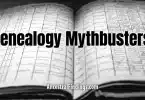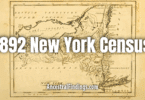The United States has taken a national census every decade since 1790. Some states have done state censuses during non-federal census years. These are excellent resources for genealogists and can reveal a lot of fascinating and new information about your ancestors. In fact, the census records are usually one of the first record sets new genealogists use in their research, as they are considered one of the most basic genealogy tools. The state censuses are useful for filling in the gaps in the federal census years, and for bridging the 20-year gap between the 1880 and 1900 federal census records since the 1890 census was destroyed in the 1930s.
However, most of us have relatives who came from other countries, unless we are 100 percent Native American. This means you’ll probably be looking at foreign record sources eventually if you want to take your family history research beyond America. The good news is that census records are not unique to America. Other nations have been using them for centuries, and they may be available to you in searching for your ancestors. Here is what you need to know about European census records.
Depending on the country you are searching, you may find census records in Europe going back into the Middle Ages, or only into the past century. Many European nations kept medieval census records, but destroyed them when they were no longer needed, or lost them to poor preservation methods through the centuries. Others have extremely well-preserved collections. Other nations, or regions within certain European nations, converted their census data to statistical abstracts that don’t include names, ages, and other household information, but just numbers in regards to how many people lived where and when in that region.
Another thing to remember about European censuses is that most of them aren’t indexed. This means you’ll need to have a good idea of the town in which your ancestors lived, when they lived there, and be willing to search page by page for them, often in foreign languages, you may not know.
Also, keep in mind that borders were continually changing in Europe, along with the names of countries, for centuries. Be sure to do your research on the country you plan on searching to be sure where its borders were located and what it was called at the time you need to search it. If the borders have changed, you might need to look in a different country than the one your ancestors lived in. Often, when borders change, the census records don’t move with them. They stay in the same place and become part of the records of the new country created from the border change. So, be sure you’re looking in the right place, to be sure you will find the census records you need to do your research.
England and Canada are exceptions to the rule when it comes to non-indexed census records. While official censuses with more than just statistical information weren’t maintained in these nations until the 1800s, the records are generally indexed and include full household name and age information, like the American census records from 1850 to the present.
Of course, not every European nation did censuses of its citizens. You can find out which ones did by searching the online catalog at FamilySearch.org to see if the nation where your ancestors lived has any censuses listed. If there are no censuses listed, it doesn’t necessarily mean none were done. It may simply mean that the Family History Center run by the Jesus Christ Church of Latter Day Saints, which maintains the website, has not added these records to its catalog yet. You can write to the national or local archives in the area you wish to search and ask them if any census records are available there.
Many European censuses are viewable online at FamilySearch.org and at Ancestry.com. You can order microfilms of the ones that aren’t online by inquiring at your local LDS Family History Center branch. Most major cities (and even some smaller ones) have one. The microfilm will be sent there, and you can use the microfilm machines there to look for your ancestors among the census pages. If the LDS library or Ancesry.com does not have what you want and you know it exists, hiring a researcher who lives or works in that area to search the censuses for you is an excellent idea. If you’re up for an adventure, you could even travel there yourself, see where your ancestors lived in person, and look at the census records on site, where translators will usually be available to assist you in reading the information in the records.
- 1831-1841 Ireland Census Index
- 1848-1864 Index to Griffith’s Valuation of Ireland
- 1851 United Kingdom Census Records
- 1871 Ontario Canada Census Index






